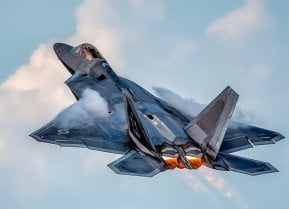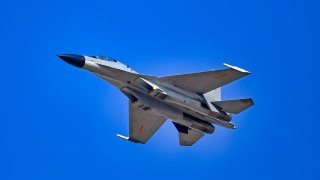J-11B: This Chinese Fighter Is No F-22 But Is Still Dangerous
The J-11B was the next variant made in China with home-built avionics and weapons. The J-11B has an improved cockpit with a heads-up display
Like the J-10 Vigorous Dragon warplane, China’s Shenyang J-11 fighter often flies missions over the Taiwan Strait to bully Taipei. At the end of September of 2022, four J-11s encroached on Taiwan by flying over the island’s median line near the northern portion of the island.
Each time this happens, it triggers a serious battle drill. Taiwan must scramble its own fighters and places surface-to-air missile systems on alert.
The J-11 will likely continue these missions. Since these incursions are now a weekly fact of life, it is illustrative to take a closer look at the J-11.
Is It Chinese or Russian?
This fighter is based on a licensed-built version (well, sort of, the history is complicated) of the Russian Sukhoi Su-27SK Flanker fighter.
The J-11 is nicknamed the Flanker or Flanker B+. It is a twin-engine, single-seat warplane that is made by Shenyang Aircraft Corporation.
It can engage in air superiority missions and strike targets on the ground in close air support or aim to destroy priority surface targets. China believes it can challenge the American F-16 Fighting Falcon or the F/A-18 Hornet. The J-11 also serves in the Chinese Navy. There are now about 200 J-11s of all variants.
In 1996, Shenyang negotiated a $2.5 billion contract with Sukhoi. Sukhoi was required to supply parts and components to Shenyang for final assembly in China of 200 J-11s. The first was tested in 1998. By 2003, only 100 had been produced. The manufacturing line was halted by the People’s Liberation Army Air Force because the flying branch was not satisfied with the base model.
J-11B Picks Up the Slack
The J-11B was the next variant made in China with home-built avionics and weapons. The J-11B has an improved cockpit with a heads-up display. Its early warning system can detect enemy fighters and has a range of over 90 miles. It can track surface ships at over 200 miles.
Global Times wrote that the “improved J-11B uses advanced active electronically scanned array (AESA) radar to replace the original version's pulse-Doppler radar … this will allow the aircraft to detect targets at longer ranges and wider angles, enjoy better situational awareness and stronger anti-jamming capability, and become capable of launching the advanced PL-15 long-range air-to-air missile.”
Diverse Range of Weapons
The J-11B weapons systems are robust with infrared and radar-guided air-to-air missiles on ten hardpoints. These come in short- and medium-range models. The bombs are laser-guided or non-precision-guided. The ground strike capability is seen as secondary to its air superiority role, but the J-11 can still destroy surface targets. Chaff and flares can be deployed to confuse enemy radar and air defenses, plus to spoof heat-seeking missiles fired from other fighters. A 30mm cannon is also included.
The cockpit enables features that other modern fourth-generation fighters also have for better situational awareness. This includes helmet-mounted sights along with color displays.
Engines Create High Speed and Range
The engines on the craft are Russian-built AL-31Fs or Chinese-made FWS-10A Taihang with turbofans with 29,000 pounds of thrust. These can push out a top speed of 1,553 miles per hour or over MACH 2. The range is 2,070 miles and the ceiling is 62,500 feet.
The J-11B is a capable fighter. It is not in the class of the F-35 or F-22 since it lacks stealth attributes. However, It has the numbers to challenge Taiwanese F-16Vs, since the airplane it was based on, the Su-27, is known for its maneuverability. But with the J-11 and its variants, it is the sheer number of airplanes that Taiwan must contend with.
Conventional ground-based missile strikes paired with an assault from the J-10 and J-11, plus the H-6 bomber, would overwhelm Taiwanese defenses and make it difficult for the defenders to ward off an attack.
About the Author
Dr. Brent M. Eastwood is the author of Humans, Machines, and Data: Future Trends in Warfare. He is an Emerging Threats expert and former U.S. Army Infantry officer. You can follow him on Twitter @BMEastwood. He holds a Ph.D. in Political Science and Foreign Policy/ International Relations.


